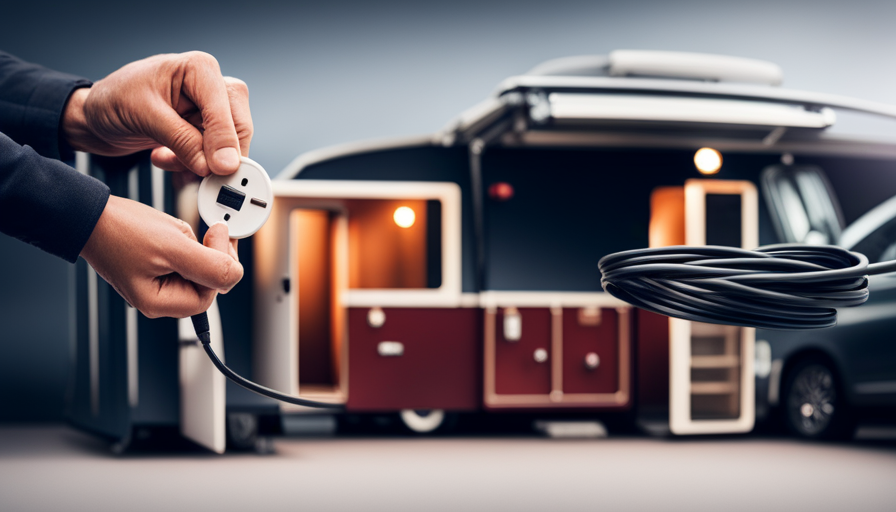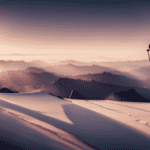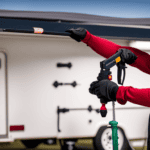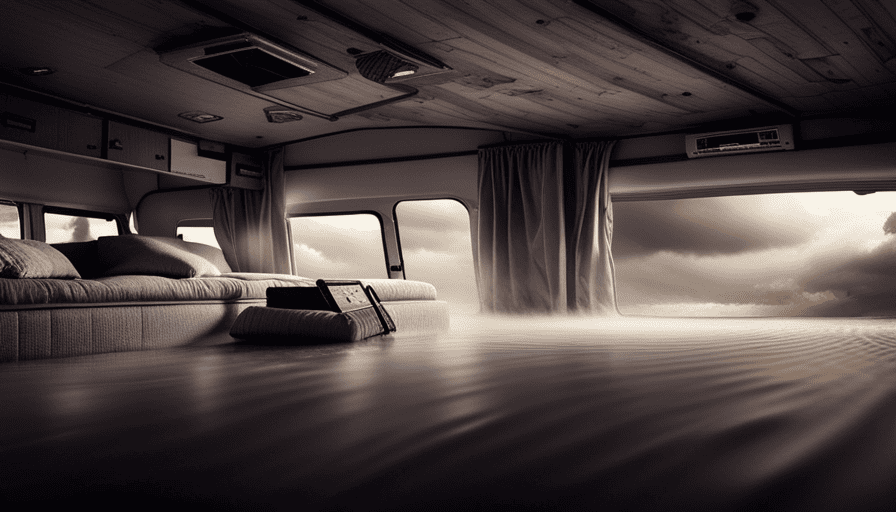Picture yourself embarking on an amazing road trip, discovering the wonders of nature in your reliable camper. However, all of a sudden, a crisis hits – a leak in your camper roof jeopardizes your adventure. No need to worry! By utilizing some basic skills and few easy-to-find materials, you can swiftly repair your camper roof and resume your journey along the scenic routes.
In this article, I will guide you through the step-by-step process of patching a camper roof. Whether you’ve encountered a minor crack or a more significant tear, I’ve got you covered. I’ll share my personal experience and expertise, gained from years of camper roof repairs, to ensure you have all the information you need to successfully fix the problem.
From assessing the damage to applying the patching material, I’ll break down each stage in a detailed and easy-to-follow manner. I’ll also provide tips on maintaining and monitoring your roof to prevent future leaks. And if you ever find yourself in over your head, I’ll advise on when it’s time to seek professional help.
So, let’s roll up our sleeves and get your camper roof back in tip-top shape!
Key Takeaways
- Assess the extent of the damage by visually inspecting the roof for cracks, holes, or leaks.
- Depending on the severity of the damage, consider options like patching small holes, replacing damaged sections, or resealing the entire roof.
- Properly clean the roof by removing debris and using mild soap or camper roof cleaner.
- Apply the patching material with a putty knife, following the manufacturer’s instructions for adhesive.
Assess the Damage
Now, take a moment to carefully examine the extent of the damage to your camper’s roof and get ready to tackle the repairs head-on. Assessing the extent of the damage is crucial before you can proceed with any repairs.
Start by visually inspecting the roof for any visible cracks, holes, or leaks. Pay close attention to the corners, seams, and edges as these are common areas where damage may occur. Use a flashlight to check for any water stains or discoloration on the ceiling inside the camper, as this can indicate a leaking roof.
Once you’ve assessed the extent of the damage, it’s time to find the best solution for repairing your camper’s roof. Depending on the severity of the damage, you may need to consider options such as patching small holes with sealant or adhesive, replacing damaged sections of the roof, or even resealing the entire roof with a protective coating. Consider factors such as the age and condition of your camper, as well as your budget and time constraints, when deciding on the best course of action.
Now that you know the extent of the damage and have determined the best solution, it’s time to gather the necessary materials for the repair.
Gather the Necessary Materials
First, you’ll need to gather all the materials required to fix the roof of your camper. The first thing you’ll need is the appropriate roof repair materials. These can include a patch kit specifically designed for camper roofs, which typically consists of a piece of rubber or other waterproof material and adhesive to secure it in place. Additionally, you’ll need a utility knife to cut the patch to the correct size and shape, as well as a brush or sponge to clean the damaged area before applying the patch. You may also want to consider purchasing camper cushion fabric options to match the color and style of your camper’s interior. This will allow you to seamlessly repair any damaged or worn cushion covers while you’re fixing the roof. Make sure to measure the dimensions of your cushions and select the appropriate fabric options to ensure a perfect fit. Once you have all the necessary materials, you can begin the process of repairing and refreshing your camper’s interior and exterior.
Before beginning the repair process, it’s crucial to properly clean the roof of your camper. This ensures that the adhesive will adhere properly and that the patch will have a strong bond with the roof surface. Start by removing any loose debris or dirt using a broom or a soft brush. Then, use a mild soap or camper roof cleaner and a sponge or cloth to thoroughly clean the damaged area. Rinse off the cleaner with water and allow the roof to dry completely before proceeding with the patching process.
With all the necessary materials gathered and the roof properly cleaned, you’re now ready to move on to the next step of the process: cleaning the roof.
Clean the Roof
Before I can begin patching the roof of my camper, I need to make sure the area is clean and free of any dirt, debris, or loose materials.
To do this, I’ll carefully remove any loose items and sweep away any dirt or debris from the damaged area. Once the area is cleared, I’ll use a mild detergent and water to thoroughly clean the roof surface, ensuring it’s ready for the patching process.
Remove any dirt, debris, or loose materials from the damaged area
To effectively patch a camper roof, start by clearing away any dirt, debris, or loose materials from the damaged area, ensuring a clean and stable foundation for the repair. As someone experienced in roof maintenance and DIY repairs, I understand the importance of this initial step. By removing any dirt and debris, you create a smooth surface for the patch to adhere to, preventing any further damage or leaks. To make this task more enjoyable, imagine yourself in a peaceful camping scene, complete with a cozy campfire and a stunning starry sky. As you clear away the dirt and debris, visualize your camper roof becoming stronger and more resilient. Once the area is clean, you can move on to the next step of using a mild detergent and water to thoroughly clean the roof surface, preparing it for the patching process.
Use a mild detergent and water to thoroughly clean the roof surface
Once you’ve cleared away all the dirt and debris, it’s time to give your roof a good scrub with a gentle detergent and water, revealing a sparkling surface that’s ready for a flawless repair. Cleaning the roof surface is an essential step in roof maintenance and DIY repairs. Here are three reasons why this step is crucial:
-
Enhanced Adhesion: A clean roof surface ensures better adhesion of the patch, preventing it from peeling off or becoming loose over time.
-
Proper Inspection: Cleaning the roof allows you to inspect it thoroughly for any hidden cracks or damage that may require additional repairs.
-
Longevity: Regular cleaning and maintenance contribute to the longevity of your camper roof, reducing the chances of costly repairs in the future.
With a pristine surface, you can now proceed to the next section and prepare the roof surface for the patch, ensuring a seamless and long-lasting repair.
Prepare the Roof Surface
After cleaning the roof surface thoroughly, it’s fascinating to note that the average camper roof can accumulate up to 5 pounds of dirt and grime over time.
Roof preparation is a crucial step in patching a camper roof. To ensure a successful repair, it’s important to create a clean, smooth, and dry surface for the patching material to adhere to.
Start by removing any loose debris, such as leaves or twigs, using a broom or a soft brush.
Next, inspect the roof for any cracks, holes, or damaged areas. Use a scraper or sandpaper to gently remove any loose or peeling paint, as well as any rust or corrosion. This’ll help the patching material bond effectively to the roof.
Afterward, use a mild detergent and water to clean the roof surface, removing any dirt, grime, or grease. Rinse thoroughly and allow the roof to dry completely before proceeding with the next step of applying the patching material.
By properly preparing the roof surface, you ensure that the patch’ll adhere securely and provide a long-lasting repair.
Now, let’s move on to applying the patching material.
Apply the Patching Material
Using a putty knife, I spread the patching material smoothly and evenly onto the surface, creating a seamless barrier that seals and protects against further damage. Applying adhesive is a crucial step in ensuring the patch adheres securely to the camper roof. I carefully follow the manufacturer’s instructions, using the recommended adhesive for the specific type of patching material being used. This ensures maximum adhesion and longevity of the repair.
Once the adhesive is applied, I begin the smoothing process. Using the putty knife, I gently press down on the patching material, smoothing out any air bubbles or wrinkles. This ensures a tight bond between the patch and the roof surface, preventing any future leaks or damage.
To further emphasize the importance of a smooth surface, I recommend the following sub-lists:
- Smooth out the edges of the patching material to create a seamless transition between the patch and the roof surface. This helps prevent water from seeping underneath the patch and causing further damage.
- Check for any imperfections or uneven areas and address them promptly. This will ensure a professional-looking repair and enhance the overall durability of the patch.
As I finish the smoothing process, it’s important to move on to the next step of securing the patch in place. This will ensure that the patch stays in position and remains effective in protecting the camper roof.
Secure the Patch
Now, it’s time to firmly lock your repair in place, ensuring it stands strong like a fortress shielding against any future harm. To achieve long-term durability and weather resistance, it’s crucial to secure the patch properly.
Start by applying pressure to the patch, making sure it adheres firmly to the camper roof. Use a roller or a smooth, flat object to remove any air bubbles and ensure a smooth surface.
Next, apply a generous amount of roof sealant around the edges of the patch. This’ll create a watertight seal and add an extra layer of protection against the elements. Make sure to extend the sealant slightly beyond the edges of the patch to ensure complete coverage.
Once the sealant is applied, smooth it out using a putty knife or a gloved finger. This’ll help to create a seamless transition between the patch and the roof surface. Pay extra attention to the corners and edges, as these areas are more prone to leaks.
Allow the patch to cure according to the manufacturer’s instructions. This’ll typically take a few hours or overnight. During this time, it’s crucial to keep the area dry and free from any debris or moisture.
Once the patch has fully cured, you can move on to the next step of the repair process.
Allow the Patch to Cure
When it comes to allowing the patch on your camper roof to cure, it’s crucial to follow the manufacturer’s instructions for the recommended curing time. This will ensure that the patch sets properly and provides a long-lasting solution.
Additionally, it’s essential to keep the patched area protected from rain or moisture during the curing process to prevent any potential damage or weakening of the patch. Trust me, I’ve learned from experience that taking these steps seriously can make all the difference in the effectiveness and durability of the patch.
Follow the manufacturer’s instructions for the recommended curing time
After applying the patch to the camper roof, it’s important to wait for the recommended curing time according to the manufacturer’s instructions. This allows the patch to fully seal and protect the roof. Following the manufacturer’s instructions for the recommended curing time is crucial, especially in different weather conditions. Extreme temperatures, whether hot or cold, can affect the curing process and compromise the effectiveness of the patch. Additionally, humidity levels can also impact the curing time.
It’s essential to avoid common mistakes when applying the patching material, such as applying it too thick or too thin, as this can affect the curing process and result in an ineffective patch. To ensure the patch cures properly, it’s important to keep the patched area protected from rain or moisture during the curing process. This will prevent any water from seeping through and compromising the patch before it fully cures.
Moving on to keeping the patched area protected from rain or moisture during the curing process…
Keep the patched area protected from rain or moisture during the curing process
To ensure the patch fully seals and protects, it’s crucial to shield the repaired area from rain or moisture during the curing process. This step is essential to maximize the protective measures taken and ensure the effectiveness of the curing process.
Water can compromise the patch’s integrity and prevent it from fully adhering to the camper roof, leading to potential leaks and further damage. To prevent this, cover the patched area with a tarp or other waterproof material until the recommended curing time has passed.
Additionally, make sure to check the weather forecast and choose a period when rain or humidity is minimal. By taking these precautions, you can enhance the patch’s durability and longevity.
Once the curing process is complete, it’s time to inspect and test the repair to ensure its effectiveness.
Inspect and Test the Repair
After patching a camper roof, it’s crucial to inspect the repaired area thoroughly. This involves closely examining the patched section for any signs of damage or weakness. Look for cracks, bulges, or loose edges that may indicate a faulty repair.
Additionally, it’s essential to conduct a water test to ensure the patch is effective and watertight. Any leaks could potentially cause further damage to the camper.
Check the patched area for any signs of damage or weakness
Inspect the patched area carefully for any indications of damage or weakness, ensuring that nothing escapes my keen eye. As an experienced camper roof patcher, I know that assessing long-term durability is crucial to a successful repair.
Look closely at the patched area and identify any potential weak spots that might compromise the integrity of the roof. Pay attention to any signs of cracking, peeling, or sagging, as these could be signs of underlying issues. Additionally, check for any areas where the patching material might not have adhered properly or where the patch is beginning to lift. These could be areas of concern that need to be addressed before continuing.
Once you have thoroughly inspected the patched area, it’s time to conduct a water test to ensure the repair is effective and watertight.
Conduct a water test to ensure the repair is effective and watertight
Now, let’s put this repair to the ultimate test and see if it can withstand a deluge of water without a single drop seeping through. Conducting a leak detection test is crucial to ensure the effectiveness and watertightness of the patch.
Begin by thoroughly wetting the patched area with a hose, making sure to simulate heavy rain conditions. Observe the repaired area closely, checking for any signs of water infiltration. Pay attention to any drips or damp spots that may indicate a weak point in the repair.
It’s essential to be thorough and patient during this process, as even the smallest leak can cause significant damage over time. Once the water test is complete and the repair has passed with flying colors, it’s time to move on to maintaining and monitoring the roof’s condition to prevent future issues.
Maintain and Monitor the Roof
To effectively keep your camper roof in good condition, it’s crucial to regularly maintain and closely monitor its overall condition. Roof maintenance is essential to prevent any potential damage or leaks that could occur. By implementing a routine inspection and following some roof maintenance tips, you can ensure that your camper roof remains in optimal shape for years to come.
During your roof inspection, pay close attention to any signs of wear and tear, such as cracks, loose seams, or damaged flashing. Additionally, check for any debris buildup, as it can lead to water pooling and potential damage. To help you visualize the importance of maintaining your camper roof, refer to the following table:
| Roof Maintenance Tips | Roof Inspection Techniques |
|---|---|
| Regularly clean debris from the roof | Inspect for cracks and loose seams |
| Check and clear gutters and downspouts | Look for signs of water damage on the ceiling inside the camper |
| Trim overhanging tree branches | Examine the roof for any signs of mold or mildew |
| Apply a protective coating to the roof surface | Check for any loose or missing shingles |
Regular maintenance and monitoring of your camper roof can help identify any potential issues before they become major problems. However, if you do encounter significant damage or are unsure about the repairs needed, it’s always wise to seek professional help. This will ensure that the necessary repairs are done correctly and efficiently, providing you with peace of mind during your camping adventures.
Seek Professional Help if Needed
If you’re uncertain about the extent of the damage or need expert advice, it’s always a good idea to consult with professionals who can help you ensure your camping experience remains worry-free. Seeking assistance from a professional can be beneficial, especially when it comes to patching a camper roof. They have the knowledge and experience to accurately assess the damage and provide you with the best course of action.
Professional advice is valuable because they can identify any underlying issues that may not be immediately visible. They have the expertise to determine if a simple patch will suffice or if a more extensive repair is necessary. By seeking professional help, you can avoid making costly mistakes and ensure that the repairs are done correctly the first time.
Additionally, professionals have access to specialized tools and materials that may not be readily available to the average camper. This allows them to perform high-quality repairs that are durable and long-lasting. They can also provide you with tips and recommendations on how to properly maintain your camper roof to prevent future damage.
Seeking professional help when patching a camper roof is a wise decision. Their expertise and knowledge will ensure that the repairs are done correctly and that your camping experience remains worry-free. Don’t hesitate to reach out to professionals for assistance and advice.
Frequently Asked Questions
Can I use any type of patching material for my camper roof, or are there specific products I should use?
You can use silicone caulk to patch your camper roof, but there are specific products that are better suited for this task. Using the right materials is crucial for ensuring a successful and long-lasting repair.
Different types of patching materials have their pros and cons. For example, silicone caulk is durable and weather-resistant, but it may not adhere well to certain types of roofing materials. It’s important to research and choose the appropriate patching material for your specific camper roof.
How long does the patching material typically take to cure and dry before it’s fully waterproof?
As the saying goes, "Rome wasn’t built in a day," and the same can be said for patching materials on a camper roof. The curing time for patching material can vary depending on the specific product used, but it typically takes around 24-48 hours to fully cure and dry.
However, it’s important to note that the waterproofing duration may take longer, as additional layers or sealants may be required for optimal protection. Patience is key when it comes to ensuring a fully waterproofed camper roof.
Is it necessary to clean the roof before applying the patching material, or can I skip this step?
Yes, it’s necessary to clean the roof before applying the patching material. Cleaning the roof ensures that there isn’t any debris, dirt, or other substances that could interfere with the adhesion of the patch. It also helps to create a clean surface for the patching material to bond to. Skipping this step could result in a weaker bond and less effective waterproofing. While there may be alternative materials available, proper cleaning is still essential for optimal results.
What are some signs that indicate I should seek professional help to repair my camper roof instead of doing it myself?
When it comes to repairing a camper roof, it’s important to know when it’s best to seek professional help.
Signs of roof damage, such as leaks, sagging, or extensive cracks, indicate that it’s time to call the experts.
Professional roof repair offers several benefits, including specialized knowledge, access to high-quality materials, and the assurance of a job well done.
It’s wise to prioritize safety and efficiency by letting the professionals handle the more complex roof repairs.
How often should I inspect and maintain my camper roof to ensure it stays in good condition?
Regular maintenance of your camper roof is crucial to ensure it stays in good condition. It is important to inspect and maintain your camper roof at least twice a year, or more frequently if you frequently use your camper or live in an area with extreme weather conditions.
Regular inspections allow you to identify and address any potential issues before they become major problems. Additionally, taking preventive measures such as keeping the roof clean, checking for leaks, and ensuring proper sealing can help prevent common causes of damage like water intrusion and UV damage.
Does Permanently Stabilizing a Camper Help in Preventing Roof Damage?
Permanently stabilizing a camper is crucial for preventing roof damage. By evenly distributing the weight and minimizing movement, stability helps prolong the life of the camper’s roof. With reduced vibrations and sway during travel or when parked, the risk of leaks, cracks, or other roof damage is significantly diminished. A stable camper ensures a safer and more enjoyable camping experience.
Conclusion
Well, folks, there you have it – the ultimate guide on how to patch a camper roof. I hope you’ve enjoyed this riveting journey through the world of roof repair.
Remember, assessing the damage is key, just like a detective solving a mystery. And don’t forget to gather your materials, because a patch won’t magically appear out of thin air.
Cleanliness is next to godliness, so make sure that roof is spick and span. And finally, apply that patching material like a pro and let it cure like a fine wine.
Inspect and test your repair, because who doesn’t love a good test? And lastly, maintain and monitor that roof like your life depends on it, because let’s face it, it kinda does. And if all else fails, don’t be afraid to call in the professionals.
Happy patching, friends!



















